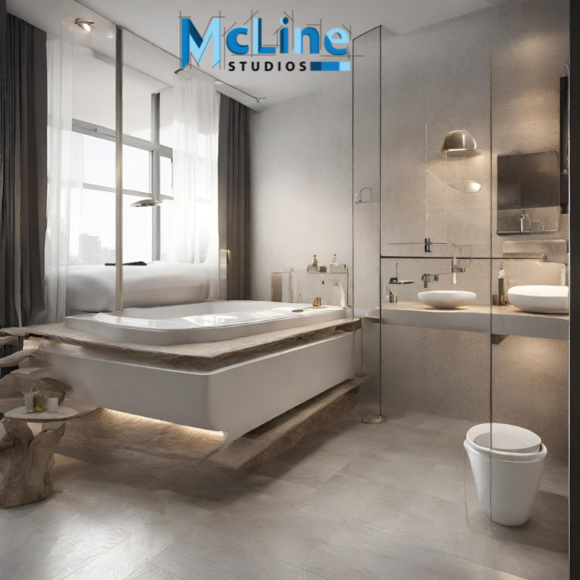In today’s design-centric industries, the role of 3D rendering has become indispensable across architecture, interior design, product design, and beyond. These industries rely on 3D rendering to transform abstract concepts into vivid, lifelike visualizations that captivate clients and stakeholders alike. High-quality renderings not only showcase design intent with unparalleled clarity but also facilitate informed decision-making by providing realistic depictions of proposed projects.
Whether it’s presenting architectural plans, showcasing interior designs, or visualizing product concepts, 3D rendering elevates presentations to new heights, setting the stage for successful collaborations and inspiring awe in viewers.
Understanding 3D Rendering
3D rendering is the process of generating two-dimensional images or animations from a 3D model. It differs from modeling, which involves creating the actual 3D geometry of objects. In the rendering process, the 3D model is enhanced with textures, materials, and lighting to create realistic or stylized visualizations.
Modeling establishes the structure of the scene, while texturing adds surface detail. Lighting setup determines how the scene is illuminated, influencing mood and realism. Finally, rendering computes the final image, applying lighting effects and simulating the interaction of light with materials to produce the desired output.

Types of 3D Rendering Techniques
1. Photorealistic Rendering:
Photorealistic rendering aims to create images that closely resemble real-life scenes. It utilizes advanced lighting, materials, and texturing techniques to achieve high levels of realism. This technique is commonly used in architectural visualization, product design, and advertising to present lifelike representations of proposed projects or products.
2. Stylized Rendering:
Stylized rendering focuses on creating visually appealing and artistic interpretations of 3D scenes. It often involves exaggerating or simplifying elements to convey a specific aesthetic or mood. Stylized rendering is popular in animation, video games, and film, where it adds visual flair and enhances storytelling.
3. Non-Photorealistic Rendering (NPR):
NPR techniques depart from realism to produce images that resemble hand-drawn or painted illustrations. This style is used in architectural concept sketches, technical illustrations, and character design to convey ideas more artistically and expressively.
Tools and Software for 3D Rendering
1. Blender:
Blender is a powerful open-source 3D creation suite offering modeling, animation, rendering, and more. It’s suitable for a wide range of projects, from architectural visualization to character animation, with a vast array of features and a supportive community.
2. Autodesk 3ds Max:
3ds Max is a comprehensive 3D modeling, animation, and rendering software widely used in architecture, product design, and entertainment industries. Its robust toolset and customizable workflows make it ideal for complex projects.
3. SketchUp:
SketchUp is known for its intuitive interface and ease of use, making it popular among architects, interior designers, and hobbyists for quick conceptualization and presentation renderings.
Tips for Creating Stunning 3D Renderings
1. Lighting Setup:
Experiment with different lighting setups to achieve the desired mood and realism. Use a combination of direct, indirect, and ambient lighting for natural-looking scenes.
2. Material Creation:
Pay attention to material properties such as texture, reflectivity, and transparency. Utilize shaders and procedural textures to add realism to surfaces.
3. Camera Composition:
Frame your shots carefully to create compelling compositions. Consider angles, focal length, and depth of field to guide the viewer’s focus.
4. Post-processing Techniques:
Enhance your renderings with post-processing effects like color correction, depth of field, and lens distortion for a polished look.
Case Studies
1. Architectural Visualization for High-Rise Development:
High-quality 3D renderings showcased the architectural vision of high-rise development, helping secure investor buy-in and municipal approvals. The realistic visuals provided stakeholders with a clear understanding of the project’s scale and design, leading to improved decision-making and streamlined project execution.
2. Product Design Rendering for Marketing Campaign:
Stunning 3D renderings of a new product enhanced marketing materials, driving consumer interest and boosting sales. The lifelike visuals effectively communicated product features and benefits, leading to increased customer engagement and satisfaction.
Challenges and Solutions
1. Long Render Times and Hardware Limitations:
Rendering complex scenes can lead to long render times and strain on hardware resources. To address this, utilize render farm services for distributed rendering, optimizing render times. Additionally, upgrading hardware components such as CPUs, GPUs, and RAM can significantly improve rendering performance.
2. Achieving Realism:
Achieving realism in 3D rendering requires attention to detail and advanced techniques. Utilize physically-based rendering (PBR) principles, high-quality textures, and accurate lighting setups to enhance realism. Implementing post-processing effects such as depth of field and motion blur can further enhance visual fidelity.
Future Trends in 3D Rendering
As technology continues to evolve, several emerging trends are reshaping the landscape of 3D rendering, paving the way for more immersive and interactive experiences.
- Real-time Rendering:
Real-time rendering technologies are becoming increasingly sophisticated, allowing artists and designers to visualize scenes instantly and make adjustments on the fly. With advancements in GPU hardware and rendering algorithms, real-time rendering is poised to revolutionize workflows across industries, enabling faster iteration and more dynamic presentations. - VR/AR Integration:
The integration of virtual reality (VR) and augmented reality (AR) with 3D rendering opens up new possibilities for immersive storytelling and interactive experiences. From architectural walkthroughs to product demonstrations, VR and AR technologies enhance engagement and enable users to explore virtual environments in unprecedented ways. - AI-driven Rendering:
Artificial intelligence (AI) is being employed to automate and optimize various aspects of the rendering process, from scene generation to lighting optimization. AI-driven rendering algorithms can analyze scene data and intelligently adjust parameters to achieve desired results efficiently. This not only accelerates rendering times but also enhances realism and quality.
These trends are poised to transform the way we create and experience 3D visualizations, opening up exciting opportunities for innovation and creativity across industries. As these technologies continue to mature, mastering them will be essential for staying competitive in the rapidly evolving world of 3D rendering.
Conclusion
Mastering 3D rendering is paramount for creating compelling visualizations that captivate audiences and drive success in various industries. At McLine Studios, we understand the importance of leveraging advanced rendering techniques to communicate design concepts effectively and engage stakeholders. By continuously honing your skills and exploring new techniques, you can elevate your rendering capabilities and stay ahead in today’s competitive landscape.
Embrace the power of 3D rendering to bring your creative visions to life and make a lasting impact in your field. Keep pushing boundaries and striving for excellence in your rendering endeavors.


